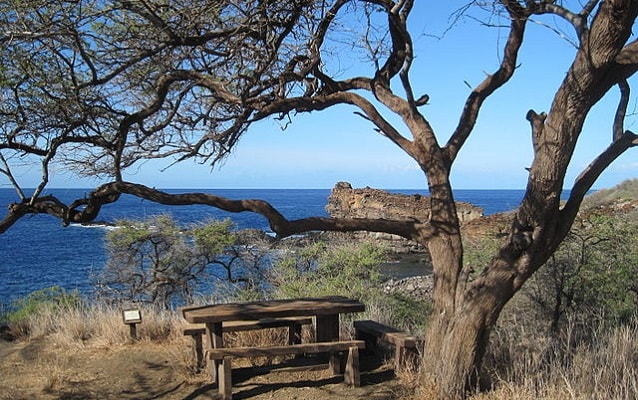Last updated: August 10, 2023
Place
Kaunolu Village Site

Photo by Joel Bradshaw, CC0
Kaunolu Village Site is located on the Island of Lanai. This ancient fishing community, occupied since at least the 1400s, consisted of a wide variety of religious structures, residences of priests, and isolated petroglyphs. It was a pu'uhonua (place of refuge) and a place Hawaiian rulers and important leaders visited when the Hawaiian Islands were a unified and independent Kingdom. Today, the Kaunolu Village Site is the largest surviving ruins of a Hawaiian village in the islands. The site is very well preserved and covers almost every phase of Hawaiian culture.
Kaunolu Village Site sits on the southern sea cliffs overlooking Kaunolu Bay, which provided a sheltered landing spot for fishing canoes. The site consists of two historic villages on the ridges of Kaunolu Gulch: the eastern Kealiakapu and the western Kaunolu. The area is very arid and the stream in the gulch is seasonal and prone to flash floods, however, the deep waters offshore are extremely rich fishing grounds and have been fished for hundreds of years.
Roughly 86 house platforms, 35 stone shelters, 9 piles of stones marking graves, and more than 30 detached pens dot the site. The Halulu Heiau, shrines, and the pu'uhonua are located at Kaunolu as well as house sites, terraces, and garden plots. Archeologists have also found 11 additional house complexes that were the residences of ali'i (chiefs). In Kealiakapu, iron scraps and pieces of earthenware pottery help date the site from the Ancient Hawaiian period. House platforms, burial sites, garden plots, stone fireplaces, and stone shelters can all be found in the area. The house platforms range from a single level to three levels, and some house sites have the remains of a terrace, an inner area, and stone papamu "boards" used to play konane, a game resembling checkers.
Beginning in the early part of the 15th century, ali'i and ali'i 'ai moku (paramount chief of an island) had residential complexes in the area. From around 1778 into the 1800s, during Kamehameha I's reign, Kaunolu was a popular fishing village because of its excellent marine resources and spectacular view. Kamehameha I had a passion for deep-water fishing and visited Kaunolu to fish and relax. Today, the site is a popular fishing spot for locals and visitors.
The people of Kaunolu also created petroglyphs, a form of rock art, throughout the village. Petroglyphs depicting abstract symbols, human figures, bird-like human figures, and animals are found in rest areas and places such as caves, overhangs, and depressions, along the trail to and near the heiau (places of worship) grounds, at boundaries, and along the route to the Halulu Heiau. Petroglyphs have special significance in relation to Hawaiian history, events, religion, the kapu system, and the well-being of the people.
The well preserved Halulu Heiau was rebuilt by Kamehameha I after he captured the Island of Lanai in the early 1800's. It was one of the last heiau built in the Hawaiian islands before Kamehameha I's son and successor, Liholiho, brought an end to the kapu system and destroyed most of the heiau on the islands. The Halulu Heiau also had an associated pu'uhonua (place of refuge), a safe haven for anyone who had broken kapu and for noncombatants and vanquished or defeated warriors during times of war. Kapu was the Hawaiian system of religious, political, and social laws that governed every aspect of daily life. The penalty for violating kapu was death. People who broke kapu were pursued by warriors until they were either captured and killed or found refuge in a pu'uhonua. After reaching the pu'uhonua, the person would go to the heiau and ask the gods for forgiveness. The priests would then perform a ceremony of absolution, which allowed the lawbreaker to return home unharmed. The Halulu Heiau compound was the only pu'uhonua on the island of Lanai.
Also located at the site is Kahekili's Leap, a rock ledge on the south shore. Kahekili, ali'i 'ai mokuto of Maui and a rival of Kamehameha's, controlled Lanai in the late 1700s and liked to visit Kaunolu. According to tradition he would make his warriors dive from the spot, a 63 foot leap off a cliff into 12 feet of water with a 15-foot rock shelf at the base, to test their courage.
A lava rock outcropping just offshore, known as Kaneapua Island, is also associated with the Kaunolu Village Site. According to tradition, the Ancient Hawaiian gods Kane, Kanaloa, and Kaneapua lived at Kaunaloa and Kaneapua Island has a small ko'a (fishing shrine) dedicated to Kaneapua on its top.
The village population began to decline in the 1880s and the area was eventually abandoned. Today, the village site is preserved for its historic value. Kaunolu Village site is a sacred place, but guided tours and a 3.5 mile long self-guided interpretive hike are available.
